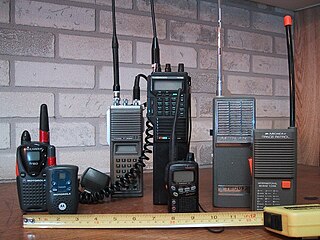
A walkie-talkie, more formally known as a handheld transceiver (HT), is a hand-held, portable, two-way radio transceiver. Its development during the Second World War has been variously credited to Donald Hings, radio engineer Alfred J. Gross, Henryk Magnuski and engineering teams at Motorola. First used for infantry, similar designs were created for field artillery and tank units, and after the war, walkie-talkies spread to public safety and eventually commercial and jobsite work.

The Hallicrafters Company manufactured, marketed, and sold radio equipment, and to a lesser extent televisions and phonographs, beginning in 1932. The company was founded by William J. Halligan and based in Chicago, Illinois, United States.

The AN/ARC-5 Command Radio Set is a series of radio receivers, transmitters, and accessories carried aboard U.S. Navy aircraft during World War II and for some years afterward. It is described as "a complete multi-channel radio transmitting and receiving set providing communication and navigation facilities for aircraft. The LF-MF-HF components are designed to transmit and receive voice, tone-modulated, and continuous wave (cw) signals." Its flexible design provided AM radiotelephone voice communication and Modulated continuous wave (MCW) and Continuous wave (CW) Morse code modes, all of which are typical capabilities in other Navy aircraft communication sets of the period. It was an improvement of the Navy's ARA/ATA command set. Similar units designated SCR-274-N were used in U.S. Army aircraft. The Army set is based on the ARA/ATA, not the later AN/ARC-5. The ARA/ATA and SCR-274-N series are informally referred to as "ARC-5", despite small differences that render all three series incompatible. Like the AN/ARC-5, the ARA/ATA and SCR-274-N had AM voice communication and two-way MCW and CW Morse code capability.

The SCR-284 was a World War II era combination transmitter and receiver used in vehicles or fixed ground stations.
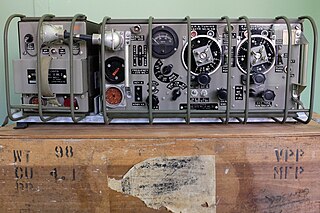
The Wireless Set No. 19 was a Second World War mobile radio transceiver designed for use by armoured troops of the British Army. First introduced in 1940, the No. 19 began to replace the pre-war Wireless Set No. 11. Two modified versions were introduced, Mk. II in 1941 and Mk. III in 1942. An improved version from Canada was introduced in 1942 for use primarily with other forces. In British service, the No. 19 was replaced in the post-war era by the Larkspur radio system. Canadian-built No. 19's saw continued service for many years with a variety of users.

The SCR-536 was a hand-held radio transceiver used by the US Army Signal Corps in World War II. It is popularly referred to as a walkie talkie, although it was originally designated a "handie talkie".
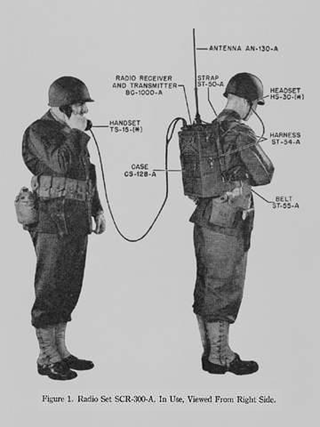
Signal Corps Radios were U.S. Army military communications components that comprised "sets". Under the Army Nomenclature System, the abbreviation SCR initially designated "Set, Complete Radio", but was later misinterpreted as "Signal Corps Radio."

The SCR-299 was a U.S. Signal Corps mobile military communications unit used during World War II.
The AN/PRC-6 is a walkie-talkie used by the U.S. military in the late Korean War era through the Vietnam War. Raytheon developed the RT-196/PRC-6 following World War II as a replacement for the SCR-536 "handy-talkie". The AN/PRC-6 operates using wide-band FM on a single crystal controlled frequency in the 47 to 55.4 MHz low band VHF band.

The BC-610 was a radio transmitter based on the Hallicrafters HT-4 and was used by the U.S. Army Signal Corps during World War II.

The SCR-300 was a portable radio transceiver used by US Signal Corps in World War II. This backpack-mounted unit was the first radio to be nicknamed a "walkie talkie".

The SCR-694 was a portable two way radio set used by the U.S. military during World War II.

The SCR-277 was a mobile, trailer mounted radio range set for radio guidance of aircraft. It was standardized by the U.S. Army in June 1941.

The BC-342 was a World War II U.S. Army Signal Corps high frequency radio receiver. It was used primarily as part of field installations such as the SCR-188A, but could be used with mobile sets such as the 2 1/2 ton mounted SCR-399. First designed at Fort Monmouth, New Jersey by the U.S. Army Signal Corps, it was built by various manufacturers including RCA. Many of the later units that are encountered today were manufactured by the Farnsworth Television and Radio Corporation of Fort Wayne, Indiana. Variants include the low frequency coverage BC-344 receiver, and the battery or dynamotor powered BC-312 receiver.
The AN/MRN-1 was an instrument approach localizer used by the Army Air Force during and after World War II. It was standardized on 3 July 1942. It replaced the SCR-241, and was a component of SCS-51.
The AN/MRN-3 was a marker beacon set used by the Army Air Force during and after World War II, it was standardized 23 October 1943, and replaced SCR-241.
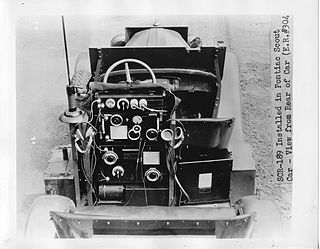
The SCR-189 was a mobile Signal Corps Radio tested by the United States Army before World War II. It was designed for armored forces, and mounted in the Six Ton Tank M1917. The original production run of these tanks included 50 "radio tanks" but the original radio components are unknown, so what or how many tanks were fitted with the SCR-189 also appears to be unknown.

The SCR-508 radio was a mobile Signal Corps Radio used by the U.S. Army during World War II, for short range ground communications. The SCR-508 series radio represented the Army's commitment to both FM and crystal tuning, and was used extensively by armor and mechanized units. The turret bustle of late series light and medium tanks was designed around this radio.
During World War II, the German Army relied on an diverse array of communications to maintain contact with its mobile forces and in particular with its armoured forces. Most of this equipment received the generic prefix FuG for Funkgerät, meaning "radio device". Occasionally the shorted Fu designation were used and there were exceptions to both these systems. Number ranges were not unique across the services so sometimes different equipment used by different services had the same FuG prefix. This article is a list and a description of the radio equipment.
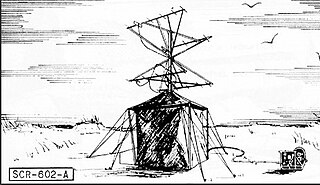
The SCR-602 also known as the AN/TPS-3, was a mobile, lightweight, medium-range, early-warning radar utilized by the United States and its allies during World War II. The radar was originally designed for use during the initial stages of an amphibious assault or military operation where its lightweight relative to other radar systems was a distinct advantage. Once larger radars such as the SCR-270 or AN/TPS-1 came online the SCR-602 could also be used to fill in gaps in radar coverage.
















